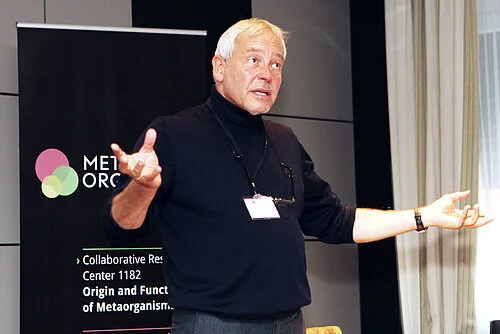Obesity,heartdiseaseordiabetescouldbetransmissible
InternationalresearchteamwiththeparticipationofKielUniversitysProfessorThomasBoschprovidesevidencethatso-called"non-communicablediseases"couldpossiblybepassedonfrompersontopersonviathemicrobiome
Diseasessuchascardiovasculardiseases,cancerorcertainlungdiseasesareamongthemostcommonnon-naturalcausesofdeathtodayandaccountforabout70percentofdeathsworldwide.TheyaredefinedbytheWorldHealthOrganization(WHO)asnon-communicablebecausetheyareassumedtobecausedbyacombinationofgenetic,lifestyleandenvironmentalfactorsandcannotbetransmittedbetweenhumans.Inanewresearchpaper,ateamfromthe"Humans&theMicrobiome"programoftheCanadianInstituteforAdvancedResearch(CIFAR),withtheparticipationofProfessorThomasBoschfromKielUniversity,isnowquestioningthisview.Thescientistsprovideconvincingevidencethatmanydiseasesclassifiedasnon-communicablemaypossiblybepassedonfrompersontopersonviathemicrobiomeafterall-andthatthemicrobialcolonisationofthehumanbody,includingbacteria,fungiandviruses,iscentrallyinvolvedinthetransmission.TheresearcherspublishedthenewhypothesislastFridayintheleadingscientificjournalScience.
Arevolutionaryhypothesis
Ifourhypothesisisprovencorrect,itwillrewritetheentirebookonpublichealth,saysBrettFinlay,ProfessorofMicrobiologyattheUniversityofBritishColumbiaandheadoftheCIFARprogram"Humans&theMicrobiome".Thescientistsbasetheirtheoryonmaking,forthefirsttime,connectionsbetweenthreedifferentalreadyprovenfindings:First,theyhavebeenabletoshowthatinawiderangeofdiseases,fromobesityandinflammatoryboweldiseasetotype-2diabetesandcardiovasculardisease,thehumanmicrobiomeshowssignificantchangescomparedtothehealthybody.Secondly,theyhaveprovidedampleevidencethatsuchalteredmicrobialcompositionsleadtothedevelopmentofdiseasewhentransferredinlaboratoryexperimentstoanoriginallyhealthymodelorganism.If,forexample,theintestinalmicrobiomeistakenfromanobesemouseandtransferredtoahealthyanimal,thelatterwillalsobecomeoverweight.Finally,theyfoundnumerousindicationsofageneralnaturaltransferabilityofthemicrobiome.Whenyouputthosefactstogether,itpointstotheideathatmanytraditionallynon-communicablediseasesmaybecommunicableafterall,saysFinlay.
ResearchersfromBosch'sgroupatKielUniversityhavebeenabletoprovethethirdaspectinparticular."Iflaboratoryanimalssuchasfreshwaterpolypsarenotkeptindividually,butratherwereco-housedforacertainperiodoftimeinacommonhabitat,theirmicrobiomefirstadaptstoeachotherandthen,asaresult,alsotheirphenotype,"summarizesco-authorBosch,spokespersonoftheCollaborativeResearchCenter(CRC)1182"OriginandFunctionofMetaorganisms"atKielUniversity."Wewereabletoshowthatthemicrobespassdirectlyfromoneindividualtoanother.Itispossiblethatthistransmissionofthemicrobiomealsotakesplaceduringhumancoexistence,forexamplethroughintensivesocialcontactsorinsharedapartments,"assumesBosch.
Furtherresearchtovalidatethetheory
TherevolutionarynewhypothesisoftheCIFARteamisbasedonanexplorativeinterdisciplinaryexchangeoftheexpertscooperatinginthemicrobiomeresearchprogramandtheirdifferentscientificperspectives.Initiatedonlyasathoughtexperiment,itquicklybecameclearthatthereareanumberofclearindicationsfromthevariousdisciplinesthatmakethenewtheoryseemplausibleshoulditbecorrect,theimplicationsforhumanhealthwouldobviouslybeextremelyimportant.Nevertheless,theresearchersstressthattheirhypothesisisdaringandthatmanyofthemechanismsinvolvedarestillunknown.Westilldon'tknowinwhatcasestransmissionincreases,orwhetherhealthyoutcomescanalsobetransmitted,saysco-authorandCIFAR-FellowMariaGloriaDominguez-Bello,professoratRutgersUniversityinNewJersey.Weneedmoreresearchtounderstandmicrobialtransmissionanditseffects, Dominguez-Bellocontinues.
However,thereisnodoubttodaythatthereisasignificantcorrelationbetweenadisturbedmicrobiomeandmanydiseases.Furtherresearchwillshowhowthemicrobiomeinteractswithotherinfluences,forexamplecertainenvironmentalconditionsandgeneticfactorsinthetransmissionofvariousdiseases."Thenewhypothesismakesitclearthatweneedtoconsiderdisturbancesinthemicrobialcolonizationofthebodyasacauseofdiseasetoamuchgreaterextentthanbefore,andthatwealsoneedtoinvestigatethepotentialtransmissionpathwaysmoreclosely,"emphasizesBosch."Inthecomingyears,thisaspectwillbeoneofthefocalpointsofourworkinourMetaorganismCollaborativeResearchCenter,"Boschcontinued.TheCRC1182,whichwaslaunchedatKielUniversityin2016,hasbeenfundedbytheGermanResearchFoundation(DFG)forafurtherfouryearsinasecondfundingphasesincethebeginningoftheyear.
AbouttheCanadianInstituteforAdvancedResearch(CIFAR):
Sinceitsfoundingin1982,CIFAR'smissionhasbeentocreateinterdisciplinaryresearchteams,involvingleadingscientistsfromaroundtheworld,toaddressscientifictopicsofparticularrelevancetosociety.Atpresent,morethan400researchersfromaround130institutionsworldwideareworkingon13interdisciplinaryresearchprojectswith,forexample,lifescience,socialortechnicalissues.TheCIFARresearchteamshaveatotalannualbudgetofaround28millioneurosattheirdisposal.Initsresearchprogram"Humans&theMicrobiome",CIFARbringsanthropologists,biologistsandotherscholarstogethertoprovidebioculturalcontexttohost-microbiomeinteractions.Theyreaskingnewquestionsaboutwhataspectsofindividualandsocietalbehaviourarecriticaltounderstandingtheroleofthemicrobiomeinhumanhealthanddevelopment.
AboutCRC1182:
TheCollaborativeResearchCentre"OriginandFunctionofMetaorganisms"isaninterdisciplinarynetworkinvolvingabout80researchersthatinvestigatestheinteractionsofspecificmicrobialcommunitieswithmulticellularhostorganisms.ItissupportedbytheGermanResearchFoundation(DFG)anddealswiththequestionofhowplantsandanimals,includinghumans,formfunctionalunits(metaorganisms)togetherwithhighlyspecificcommunitiesofmicrobes.TheaimofSFB1182istounderstandwhyandhowmicrobialcommunitiesformtheselong-termconnectionswiththeirhostorganismsandwhatfunctionalconsequencestheseinteractionshave.TheSFB1182bringstogetherscientistsfromfivefacultiesofKielUniversity,theGEOMARHelmholtzCentreforOceanResearchKiel,theMaxPlanckInstituteforEvolutionaryBiologyPln,theHeinrich-Heine-UniversittDsseldorf,theLeibnizInstituteforScienceandMathematicsEducationandtheMuthesiusUniversityofFineArtsandDesign.
Originalpublication:
B.B.FinlayandCIFARHumansandtheMicrobiome(2020):Arenoncommunicablediseasescommunicable?
SciencePublishedon17January2020
DOI:10,1126/science.aaz3834
ListofAuthorsandAffiliations:
Moreinformation:
ResearchProgram"Humans&theMicrobiome",
CanadianInstituteforAdvancedResearch(CIFAR):
www.cifar.ca/research/program/humans-the-microbiome
BoschLab,KielUniversity:
www.bosch.zoologie.uni-kiel.de
Finlay-Lab,Michael-Smith-Laboratories,
UniversityofBritishColumbia,Vancouver:
www.msl.ubc.ca/people/dr-brett-finlay
CRC1182"OriginandFunctionofMetaorganisms",KielUniversity:
www.metaorganism-research.com
Contact:
Prof.ThomasBosch
SpeakerCRC1182"OriginandFunctionofMetaorganisms",
KielUniversity
+49(0)431-880-4170
tbosch@zoologie.uni-kiel.de
Presscontact:
ChristianUrban
SciencecommunicationKielLifeScience",KielUniversity:
+49(0)431-880-1974
curban@uv.uni-kiel.de



